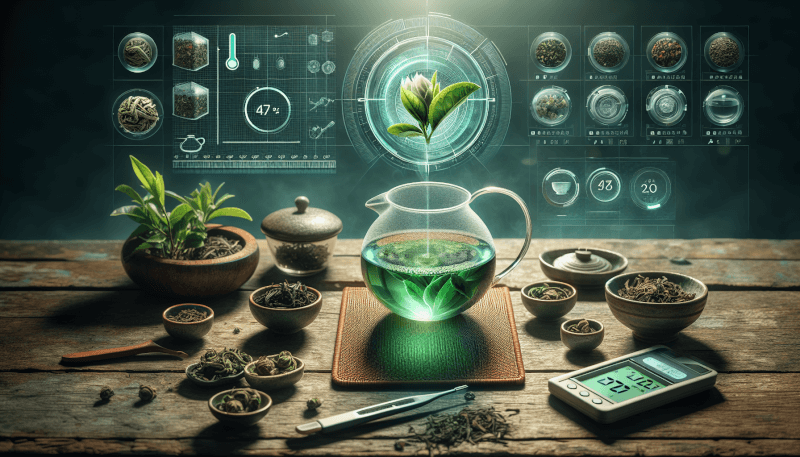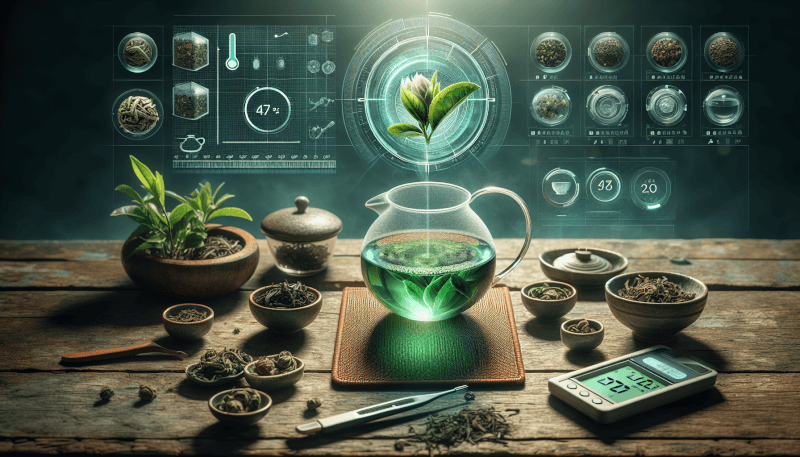Green tea is a beloved beverage that not only offers a refreshing taste but also numerous health benefits. Whether you’re new to the world of green tea or a seasoned tea enthusiast, it’s important to know the right way to brew it for the perfect cup. In this article, we will guide you through the steps to properly brew green tea, ensuring that you get the maximum flavor and all the goodness it has to offer. So grab your teapot and get ready to elevate your tea-drinking experience to a whole new level!

Choosing the Right Green Tea
When it comes to choosing the right green tea, there are a wide variety of options available. Each variety offers a unique flavor profile and aroma, so it’s important to understand the differences before making your selection. Some popular varieties include sencha, matcha, genmaicha, and hojicha.
Sencha is the most common type of green tea in Japan and is known for its grassy and slightly sweet flavor. Matcha, on the other hand, is a powdered form of green tea that is whisked into hot water, resulting in a vibrant and slightly bitter flavor. Genmaicha is a green tea combined with roasted brown rice, offering a nutty and toasty taste. Lastly, hojicha is made from roasted tea leaves, giving it a distinct earthy and smoky flavor.
To choose the right green tea, consider your personal preferences. If you enjoy a fresh and light taste, sencha might be the perfect choice for you. If you’re looking for a bold and intense flavor, matcha could be the way to go. Take the time to explore different varieties and find the one that suits your taste buds best.
Understanding Different Varieties
Green tea comes in many different varieties, each with its own unique characteristics. Understanding these varieties can help you make an informed decision when choosing which green tea to brew. Some common types of green tea include sencha, matcha, genmaicha, and hojicha.
Sencha is a popular variety of green tea in Japan. It is grown in direct sunlight, giving it a bright green color and a fresh, grassy flavor. Sencha is often enjoyed on its own, without the addition of any sweeteners or milk.
Matcha, on the other hand, is a powdered form of green tea that is whisked into hot water. This vibrant green tea has a slightly bitter and earthy flavor. Matcha is often used in traditional tea ceremonies and can also be used in baking and cooking.
Genmaicha is a unique green tea that is combined with roasted brown rice. This combination gives the tea a nutty and toasty flavor. Genmaicha is often enjoyed as a casual tea and pairs well with savory dishes.
Hojicha is a roasted green tea that has a distinct smoky flavor. It is made by roasting green tea leaves, which gives the tea a darker color and a rich, earthy taste. Hojicha is often enjoyed in the evening as it is a low-caffeine tea.
By understanding the different varieties of green tea, you can choose the one that best suits your preferences and enjoy a truly satisfying cup.

Selecting High Quality Leaves
When it comes to brewing green tea, selecting high-quality leaves is crucial. The quality of the tea leaves can greatly impact the flavor and aroma of your brew. Here are a few things to consider when selecting your green tea leaves.
First and foremost, look for tea leaves that are whole or in large pieces. Avoid tea bags or broken leaves as they may produce a lower quality brew. Whole tea leaves contain more essential oils and flavor compounds, resulting in a more flavorful cup of tea.
Additionally, pay attention to the color and appearance of the tea leaves. High-quality green tea leaves will have a vibrant green color and a glossy appearance. Avoid tea leaves that appear dull or have yellowing edges, as this may indicate that they are past their prime.
Another important factor to consider is the freshness of the tea leaves. Green tea is best consumed within six to twelve months of its harvest. Be sure to check the packaging for the harvest date to ensure that you are purchasing fresh tea leaves.
Lastly, consider purchasing tea from reputable sources. Look for trusted tea brands or specialty tea shops that have a reputation for selling high-quality teas. This will ensure that you are getting the best possible green tea leaves for your brew.
By selecting high-quality tea leaves, you can enjoy a flavorful and aromatic cup of green tea that truly showcases the unique characteristics of the tea variety.
Preparation and Equipment
Preparing a delicious cup of green tea requires gathering the necessary supplies and using the right equipment. Here are a few key considerations when it comes to preparation and the equipment needed.
Gathering the Necessary Supplies
Before you begin brewing your green tea, gather all the necessary supplies. You will need:
- A tea infuser or tea bags, depending on whether you are using loose leaf tea or tea bags.
- A teapot or teacup, depending on how many servings you want to make.
- A tea kettle or pot to boil the water.
- A timer to keep track of the steeping time.
- A mug or teacup to enjoy your finished cup of tea.
Having all these supplies ready ensures that you’re fully prepared to start the brewing process and avoids any last-minute scrambling to find what you need.
Measuring the Perfect Amount of Tea
Once you have gathered your supplies, the next step is to measure the perfect amount of tea. This can vary depending on personal taste and the specific variety of green tea you are using.
As a general guideline, for a single cup of green tea, use approximately one to two teaspoons of loose leaf tea or one tea bag. If you prefer a stronger flavor, you can add an extra half teaspoon of tea or use a higher-quality tea with larger leaves, as they require more space to expand and release their flavors.
For larger quantities of tea, such as a teapot, adjust the amount of tea accordingly. As a rough estimate, use one teaspoon of tea per cup of water.
By measuring the perfect amount of tea, you can ensure a consistent and well-balanced flavor with each cup you brew.

Water Temperature and Quality
The quality of both the water and the temperature at which it is heated play a significant role in brewing the perfect cup of green tea. Here are some important factors to consider when it comes to water temperature and quality.
Using Filtered or Spring Water
One of the first things to consider when brewing green tea is the quality of the water. Filtered or spring water is recommended as tap water may contain impurities and affect the taste of your tea.
Using filtered or spring water helps to ensure a clean and pure flavor, allowing the true characteristics of the tea to shine through. It is worth investing in a water filter or purchasing bottled spring water specifically for brewing tea if your tap water is not of the highest quality.
Determining the Ideal Temperature
Water temperature is crucial when it comes to brewing green tea. Unlike other types of tea, green tea requires a lower water temperature to prevent it from becoming bitter.
The ideal water temperature for brewing green tea is around 170 to 180 degrees Fahrenheit (77 to 82 degrees Celsius). If the water is too hot, it can scorch the delicate green tea leaves, resulting in a bitter and unpleasant taste. On the other hand, water that is too cold will not fully extract the flavors from the leaves, resulting in a weak and insipid cup of tea.
Investing in a digital thermometer or electric kettle with temperature control can help you achieve the perfect water temperature consistently. Alternatively, you can bring the water to a boil and then let it cool for a few minutes before steeping your tea.
By using filtered or spring water and determining the ideal water temperature, you can ensure that you are setting the stage for a perfectly brewed cup of green tea.
Steeping Techniques
The steeping technique you choose can have a significant impact on the flavor and strength of your green tea. Whether you prefer using loose leaf tea or tea bags, here are a few tips to help you achieve the best results.
Using Loose Leaf Tea
Using loose leaf tea allows for greater control over the strength and flavor of your green tea. When using loose leaf tea, follow these steps:
- Measure the desired amount of tea leaves. As a general guideline, use one to two teaspoons per cup of water.
- Place the tea leaves in a tea infuser or tea filter bag, ensuring that there is enough space for the leaves to expand during brewing.
- Heat the water to the appropriate temperature for the specific variety of green tea you are using.
- Pour the hot water over the tea leaves in the teapot or teacup.
- Allow the tea leaves to steep for the recommended time, usually between two and three minutes.
- Remove the tea leaves from the water to prevent over-steeping.
- Pour the brewed tea into your teacup or mug and enjoy.
Using loose leaf tea allows the leaves to fully expand and release their flavor, resulting in a more robust and aromatic cup of green tea.
Utilizing Green Tea Bags
Green tea bags offer convenience and simplicity, making them an excellent choice for those who want a quick and easy cup of tea. Here’s how to brew green tea using tea bags:
- Heat the water to the appropriate temperature for the specific variety of green tea you are using.
- Place the tea bag in a teacup or mug.
- Pour the hot water over the tea bag, filling the cup with water.
- Allow the tea bag to steep for the recommended time, usually between two and three minutes.
- Remove the tea bag from the cup to prevent over-steeping.
- Give the tea a gentle stir and enjoy.
Tea bags are a convenient option when you don’t have loose leaf tea on hand or prefer a hassle-free brewing method. However, keep in mind that tea bags may not always have the same quality of tea leaves as loose leaf tea.
By choosing the steeping technique that best suits your preferences and needs, you can enjoy a perfectly brewed cup of green tea every time.

Steeping Times
The steeping time is a crucial element in achieving the desired flavor and strength of your green tea. Different varieties of green tea require different steeping times to bring out their best qualities.
Ideal Steeping Times for Different Green Teas
Here are some general guidelines for steeping times based on common varieties of green tea:
- Sencha: Steep for two to three minutes.
- Matcha: Whisk into hot water until the tea reaches a frothy consistency.
- Genmaicha: Steep for two to three minutes.
- Hojicha: Steep for one to two minutes.
It’s important to note that these times are just starting points. You can adjust the steeping time based on your personal taste preferences. If you prefer a stronger flavor, you can extend the steeping time by 30 seconds to one minute. Likewise, if you prefer a milder flavor, you can reduce the steeping time slightly.
Experimenting with Steeping Times
Steeping times can also be adjusted based on the quality and freshness of the tea leaves. For example, if you are using high-quality loose leaf tea, you may find that a shorter steeping time is sufficient to achieve the desired flavor. On the other hand, if you are using lower-quality tea leaves, a longer steeping time may be necessary to extract the flavors fully.
Don’t be afraid to experiment with different steeping times to find what works best for you. Keep a record of the tea variety, the amount of tea used, and the steeping time to help you make adjustments in the future.
By understanding the ideal steeping times for different green teas and experimenting with personal preferences, you can brew a cup of green tea that is perfectly suited to your taste.
Proper Tea-to-Water Ratio
Finding the right tea-to-water ratio is essential for achieving a well-balanced and flavorful cup of green tea. Here’s how to determine the perfect ratio and adjust it to suit your personal preferences.
Understanding the Golden Ratio
The golden ratio for brewing green tea is typically one teaspoon of tea per cup of water. However, this ratio can be adjusted based on personal taste preferences.
If you prefer a stronger flavor, you can increase the amount of tea used by adding an extra half teaspoon or using a higher-quality tea with larger leaves that require more room to expand. This will result in a more robust and flavorful cup of tea.
Conversely, if you prefer a milder flavor, you can decrease the amount of tea used slightly. Keep in mind that reducing the amount of tea may result in a lighter and less pronounced flavor.
Adapting Ratios to Personal Preferences
Finding the ideal tea-to-water ratio is a matter of personal preference. It may take some trial and error to determine the perfect balance for your taste buds. Start with the recommended golden ratio of one teaspoon of tea per cup of water and make adjustments from there.
As you experiment with different ratios, take note of the results. Keep track of the amount of tea used and the resulting flavor to help guide you in future brewing sessions. Over time, you’ll find the tea-to-water ratio that suits your taste and allows you to brew a consistently delicious cup of green tea.
By understanding the golden ratio and adapting it to your personal preferences, you can enjoy a green tea that is perfectly suited to your taste.

Enhancing Flavor with Additions
While green tea is delicious on its own, you can enhance its flavor by adding various ingredients and spices. Here are a couple of suggestions to explore:
Adding Lemon or Citrus
Adding a squeeze of lemon or a slice of citrus can brighten and enhance the flavor of green tea. The citrusy notes complement the natural floral and grassy flavors of the green tea, creating a refreshing and invigorating cup.
To add lemon or citrus to your green tea, simply squeeze the juice of half a lemon or add a slice of citrus fruit to your teacup before pouring in the brewed tea. Allow the flavors to infuse for a minute or two before sipping.
Exploring Herbs and Spices
Another way to enhance the flavor of green tea is by experimenting with herbs and spices. Consider adding a sprig of fresh mint, a slice of ginger, or a dash of cinnamon to your tea. These additions can impart unique flavors and aromas, making each cup of green tea a delightful and memorable experience.
You can also try blending different herbs and spices to create your own custom tea blends. For example, mix green tea with dried lavender flowers for a calming and soothing tea, or add a pinch of cardamom and cloves for a warming and aromatic brew.
The possibilities are endless when it comes to enhancing the flavor of green tea with additions. Don’t be afraid to get creative and explore different flavor combinations to find your perfect cup.
Storing and Preserving Green Tea
Proper storage is essential for maintaining the freshness and flavor of your green tea. Here are a few tips to help you store and preserve your tea effectively.
Proper Storage Containers
Green tea should be stored in airtight containers to protect it from exposure to light, air, and moisture. Choose a container that is opaque or made of dark-colored glass to prevent light from reaching the tea leaves, as exposure to light can degrade the quality of the tea.
Mason jars or metal tins with a tight-fitting lid are excellent choices for storing green tea. Ensure that the container is clean and dry before transferring the tea leaves to prevent any moisture from affecting the quality of the tea.
Avoiding Exposure to Light and Moisture
Exposure to light and moisture can degrade the quality of green tea and affect its flavor. Avoid storing green tea in clear containers or in areas where it may come into contact with direct sunlight.
Additionally, keep your green tea away from areas with high humidity, such as the bathroom or near the stove. Moisture can cause the tea leaves to lose their flavor and become stale.
Store your green tea in a cool, dry, and dark place, such as a pantry or cupboard, to ensure maximum freshness and flavor retention.
By storing your green tea properly and protecting it from light and moisture, you can enjoy a cup of green tea that is bursting with flavor and aroma.
Health Benefits of Green Tea
In addition to its delightful taste, green tea offers numerous health benefits. Here are a couple of ways in which green tea can improve your wellbeing.
Promotes Weight Loss
Green tea is known to boost metabolism, which can aid in weight loss. The catechins in green tea help increase fat oxidation and improve insulin sensitivity, leading to more efficient calorie burning.
Drinking green tea before a workout may also enhance fat-burning capabilities, making it an excellent choice for those looking to shed a few pounds. Additionally, green tea can help to suppress appetite, reducing the urge to snack between meals.
Boosts Brain Function
Green tea contains caffeine, which acts as a mild stimulant, boosting alertness and concentration. It also contains an amino acid called L-theanine, which has been shown to have calming effects on the brain.
When consumed together, caffeine and L-theanine work synergistically, improving brain function and cognitive performance. Green tea has been found to enhance memory, attention, and reaction time, making it an ideal beverage for staying focused and alert throughout the day.
While green tea offers many health benefits, it’s important to remember that it is not a miracle solution. Incorporating green tea into a balanced and healthy lifestyle can contribute to overall wellbeing.
Common Mistakes to Avoid
Making green tea can be a straightforward process, but there are a couple of common mistakes to avoid to ensure the best possible brew.
Using Boiling Water
Green tea requires a lower water temperature compared to black or herbal teas. Using boiling water can scorch the delicate green tea leaves and result in a bitter and astringent brew.
Be sure to heat the water to the appropriate temperature, around 170 to 180 degrees Fahrenheit (77 to 82 degrees Celsius), before steeping your green tea. This will help to preserve the delicate flavors and prevent your tea from turning bitter.
Over-Steeping the Tea
Steeping green tea for too long can lead to a bitter and unpleasant taste. The ideal steeping time for most green teas is between two and three minutes. Leaving the tea in the water for an extended period can result in over-extraction of the flavors and tannins, leaving you with a bitter cup of tea.
To prevent over-steeping, use a timer to keep track of the steeping time. Remove the tea leaves or tea bag promptly once the desired time has elapsed. This will ensure that you achieve a perfectly balanced and flavorful cup of green tea.
By avoiding these common mistakes, you can enjoy a delicious cup of green tea that is free from any unpleasant flavors or bitter aftertaste.
In conclusion, brewing the perfect cup of green tea is a delightful and rewarding experience. By understanding the different varieties of green tea, selecting high-quality leaves, and mastering the art of preparation, you can enjoy a cup of green tea that truly satisfies your taste buds. Remember to experiment with different steeping times, ratios, and flavor additions to find your own personal blend. Green tea not only offers a delicious taste but also numerous health benefits, making it a wonderful beverage to incorporate into your daily routine. So, grab your favorite green tea, follow these tips and techniques, and embark on a journey of flavor and wellness. Cheers to the perfect cup of green tea!


